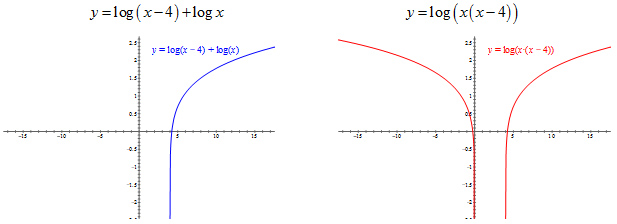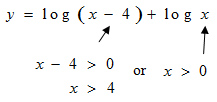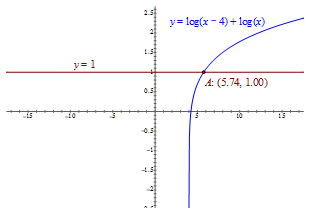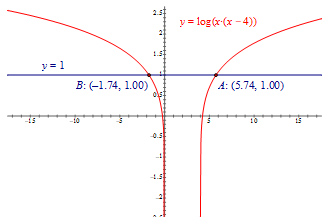log(x - 4) + logx = log[x(x - 4)] = 1

This section will explain domain dangers when simplifying a logarithmic equation before solving graphically or with tables.
Consider the following logarithmic equation: log(x − 4) + logx = 1. If you were to simplify the left side using log rules, how would you simplify it?
While it would appear that the two log expressions are equivalent, there is danger in simplifying a log expression in an equation you are attempting to solve graphically or with a table.
Here's why: compare the graphs of the two log expressions.

Why aren't they the same graphs? According to our log rules, the expressions are equivalent.
By simplifying the expression and rewriting the sum of two logs as the log of a product, we've changed the domain of the expression.
Let's look at the domain of the function on the left, y = log(x − 4) + logx , remember we cannot take the log of a negative number or 0.

Since x > 4 is more restrictive than x > 0, the domain of this equation is {x > 4}
Now, let's consider our simplified equation, y = log(x(x − 4)), again, remember we cannot take the log of a negative number or 0, therefore, x(x − 4) > 0. For the product of x and (x − 4) to be greater than 0, their product must be positive. The two factors are either both positive or both negative: x (x − 4) > 0
The domain of our simplified equation is {x < 0 or x > 4}. By applying our log rules and simplifying the equation, we changed the original domain from {x > 4} to {x < 0 or x > 4}.
(+)(+) = +
x > 0 and x − 4 > 0
∴ x > 0 and x > 4
∴ x > 4
OR
(−)(−) = +
x < 0 and x − 4 < 0
∴ x < 0 and x < 4
∴ x < 0
Why does this matter? Going back to our original problem, we were trying to solve the equation log (x − 4) + logx = 1. The solution for that equation is shown below.

But if we simplify the left side of our original equation to log (x(x − 4)) = 1 and use a graph to solve it, we get the following:

By simplifying the equation the domain changed and extraneous solutions were introduced. You do not want to do that. Therefore, the only solution for the original equation is x = 5.77.
If you are solving a log equation graphically (or with your table, since both a graph and a table is dependent on what you enter in Y=), do not simplify the equation using log rules!
![]() Match the correct equation with the domain and the graph(s) that shows the solution(s) to each equation.
Match the correct equation with the domain and the graph(s) that shows the solution(s) to each equation.